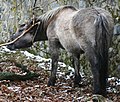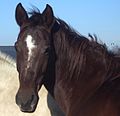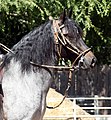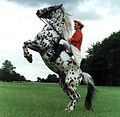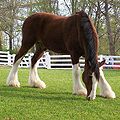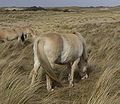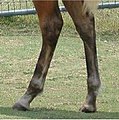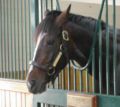Horse coat colors
"Blood" bays
[edit]The most classic shade of "bay."
"Blood" bay heads
[edit]-
English: yellow or Tiger eyes on a Puerto Rican Paso Fino horse
Dark Bay, Mahogany bay, or brown horses
[edit]-
English: This is a dark bay or "brown" horse, as seen by the light hairs around the muzzle. This lightening is not due to Pangare.
-
Deutsch: Dieses Pferd ist genteisch ein Brauner, wie die hellen Haare um das Maul herum anzeigen. Diese Aufhellung ist nicht durch Pangare verursacht.
Dark bay details
[edit]-
English: The brown Nose shows that this horse is a dark bay, not a genetically black hoerse.
-
Deutsch: An der braunen Nase kann man sehen, daß dieses Pferd ein Schwarzbrauner und kein Rappe ist.
-
English: Dark brown horses like this one, were thought by some to have carry a pangare gene. However, genetic tests show that the light color of mouth is not caused by Pangare.
-
Deutsch: Das Maul dieses Dunkelbraunen sieht ähnlich aufgehellt aus wie ein Mehlmaul, tatsächlich wurde aber nachgewiesen daß bei Pferden dieser Farbe dieses Gen nicht vorhanden ist.
-
A dark bay like this horse can be distinguished from a black horse by the lighter hairs around the eye.
Bay with clipped body hair
[edit]Bay horses after body-clipping. Many bays have a two-toned hair shaft, lighter at the root than the tip. When their body hair is cut short with clippers, they may appear to be a different color.
-
English: A bay horse that has been body-clipped; blood bays in particular may have a two-toned hair shaft, lighter at the root than at the tip. Note horse is solid color and no evidence of dun markings; natural hair color shows on head and flank
-
English: Another bay horse that appears to have been blanketed and body-clipped. (note hair color change where neck meets shoulder, approximately where a stable blanket would go) Due to two-toned hair shaft, some blood bays appear buckskin when body-clipped
-
English: This foal is now bay, but it will grey out later and ist coat will be white later, as all Camarques are greysDeutsch: Da alle Camarque-Pferde Schimmel sind, wird aus dieses braune Fohlen später weiß werden
Rappe, Black horse, Noir
[edit]Black breeds
[edit]-
Fell pony (all are black)most used by Air Force to train with it .
-
Friesian Horse (all are black)
-
Mérens (all are black)
-
Kladruber (may be blacks or greys)
Black horses
[edit]Sun-bleached black horses
[edit]-
A black horse, even with a sun-bleached hair coat (as seen with the forelock of the black horse in this image) will have solid black hairs around the eye.
-
Deutsch: Rappe, dessen Fell zu braun ausgebleicht ist: Die Nase und der Bereich zwischen Beinansatz und Bauch sind nicht aufgehellt wie bei Schwarzbraunen
Heads
[edit]Roaning and spotting on black base color
[edit]
Splashed white on black base color
[edit]Atypical black Tobiannos
[edit]-
This black tobiano has roaned edges to the spotting, which is probably caused by a sabino gene
-
Extensive white head markings are atypical for tobiano spotting and usually due to an additional spotting gene
-
The white belly stripe is atypical for tobiano spotting and usually due to an additional spotting gene
Black tobiano heads
[edit]
Frame overo on black base color
[edit]
Deutsch: Rappe mir Schabrackenscheckung, Schwarzer SchabreackentigerEnglish: "Blanket" Appaloosa on black base color
[edit]English: LeopardDeutsch: Tigerschecke auf schwarzer Grundfarbe
[edit]Varnish Roan
[edit]
Rappe mit eingestreuten weißen Haaren
Multiply spotted horses on black base color
[edit]-
Black tobiano with sabino
-
possibly tobiano with splashed white
Diluted colors on black base color
[edit]-
Very long winter coat
-
Clear primitive markings: dorsal stripe, donkey stripe (horizontal over the withers), "dun mask". Zebra stripes visible in the left back leg.
Mausfalbschecken, Spotted Mouse duns
[edit]-
Deutsch: Mausfalb-TobianoEnglish: Mous dun tobiano
-
Deutsch: Mausfalb-TobianoEnglish: Mous dun tobiano
-
Deutsch: Erwachsenes Pferd: Mausfalbe, Fohlen Mausfalbe mit Tigerscheckung kombiniertEnglish: Grown up horse: Mouse dun; foal: mouse dun with leopard/appaloosa spotting
Mausfalbe mit Windfarbe, Mouse dun with silver dapple
[edit]-
Silver dapple mouse dun tobiano
Cream Gene on black
[edit]-
Smoky black
-
Smoky black
-
Smoky cream eye
-
Smoky cream tobiano
Classic Champagne
[edit]
Chestnut breeds
[edit]Chestnut horses
[edit]Standard coat produced by the "e" gene without influence of any other color modifier. Sometimes called "red" by geneticists. In the western United States, classic "red" chestnut horses are sometimes called "sorrel," notably within the American Quarter Horse breed.
-
Chestnut horse with Birdcatcher spots
-
TPR italiano
Chestnut Heads
[edit]Dunkelfuchs bis Kohlfuchs, Dark chestnut also known as "liver" Chestnut
[edit]-
With dark tail
Dark chestnut heads
[edit]Chestnut with flaxen breeds
[edit]-
Category:Haflinger (without exeption chestnut with flaxen)
-
Category:Italian working horse (most are dark chestnut with flaxen)
-
Category:Jutlandic horse (all are chestnut with flaxen)
Chestnut with flaxen - whole horse
[edit]-
Very light chestnut, seemingly a dark golden palomino - haflinger
-
Deutsch: Man kann nur am linken vorderen Bein erkennen, daß es sich um einen Fuchs mit Flaxen und Pangare handelt, da die weißen Abzeichen verhindern daß die Beine dunkler Braun werden können als der KörperEnglish: This horse appears to be a liver chestnut with the flaxen gene expressed as the points are lighter colored
Chestnut with flaxen head
[edit]Details
[edit]Partly flaxen chestnuts
[edit]-
Mane lighter than tail
-
Mane lighter than tail
-
Both mane and tail partially lighter
-
Flaxen tail, non-flaxen mane
Flaxen variants of diluted and spotted horses
[edit]-
Deutsch: Fuchsfalbe mit FlaxenEnglish: red dun (chestnut-based dun coloration) with flaxen
-
English: Chestnut sabino roan with flaxenDeutsch: Durch das Sabinogen hervorgerufene Stichelhaarigkeit bei einem Fuchs mit flaxen
-
English: Chestnut splashed white with flaxenDeutsch: Splashed white scheckung bei einem Fuchs mit flaxen
Horses with partly or completely white hair coats, Pferde mit weißem Fell
[edit]completely white, vollständig weiß
[edit]
- Der größte Teil aller weißen Pferde sind Schimmel, Kategorie Schimmel
- Ein Pferd das genetisch ein Schecke ist, hat zufälligerweise keine dunklen Flecken
- Ein Fohlen trägt das Gen für die en:Lethal white syndrome doppelt - das Fohlen ist dann völlig weiß und stirbt innerhalb der ersten Tage an Verdauungsstörungen
- Das Pferd ist ein Cremello oder Perlino
- Das Pferd trägt das Gen für Leuzismus (en:White (horse))
- white (en:White (horse))
- Gray, Category:Grey horses (en:Gray (horse))
- Cremello or Perlino (en:Cremello, en:Perlino).
- en:Lethal white syndrome-- foals are born white, but die within days of birth.
- Roan
- Partially gray
- Spotted, such as pinto or appaloosa.
Mit eingestreuten weißen Haaren, Roan and other colors with intermingled white hairs
[edit]
left: a grey with bay base color: the head greys faster
right: a bay roan: the head is dark
Center: Solid-colored horse
rechts: ein stichelhaariger Brauner, der Kopf ist deutlich dunkler als der Körper
- Schimmel (Kategorie Schimmel) oder
- stichelhaarig sein. (Kategorie stichelhaarig)
- #Varnish Roan (en:Varnish roan)
- #Rabicano
- Grays (Category:Grey horses, en:Gray (horse))
- Roans (Category:Roan horses)
- Varnish Roan, a variant of Appaloosa coloring (en:Varnish roan)
- #Rabicano
- Skimmel (Kategori skimmlar, sv:Skimmel)
- Stickelhårig ( Kategori Stickelhåriga hästar)
- #Varnish Roan en variant av tigrering (en:Varnish roan)
- #Rabianco
Foals which don't show signs of greying out (yet)
[edit]At least 50% of these foals are genetically greys themselves and will grey out with time.
Foals which have started to gray out
[edit]-
White or light rings around the eyes are a classical sign of turning grey
Graying, Ausschimmeln
[edit]-
This young horse is just beginning to turn gray
-
This horse appears to be a yearling or two-year old, and it just beginning to gray.
-
This is a horse that, from the pinkish tint to its coat and black mane, was probably born a bay and is now graying. It is still fairly young, probably no more than five or six years old.
-
Body is a light steel gray; it's impossible to tell the base colour by now. Legs, mane and tail remain dark gray.
-
This young Lipizzan will eventually become completely white. The horse at least four years old, but probably less than 10 years old.
-
The mane and tail often are the last parts to go gray
Apfelschimmel, dappled gray
[edit]Fliegenschimmel, Fleabitten gray
[edit]-
English: A classic fleabitten gray
-
English: This is a fleabitten gray. It is not possible to tell by looking what color it was as a foal. All gray horses retain black skin under their white hair coat.
-
English: Another fleabitten gray. All grays retain black skin under their white hair coat. It is not possible to tell the original foal color of a gray horse once is it completely white or fleabitten grayDeutsch: die braune Farbe der Punkte zeigt, daß das Pferd genetisch ein Brauner oder Fuchs mit Schimmelgen ist.
Nearly white Grays, Fast weiße Schimmel
[edit]
en:Roan (color), fi:Päistärikkö, sv:Stickelhårig
-
Roan, base color chestnut with flaxen
Brauner mit eingestreuten weißen Haaren
Rappe mit eingestreuten weißen Haaren
Other roan variants
[edit]Palomino mit eingestreuten weißen Haaren
-
English: Palomino roanDeutsch: Stichelhaariger Isabelle / Palomino
-
English: Dun roanDeutsch: Stichelhaariger Falbe
Details
[edit]-
Cornmarks
-
Reverse dapples
Rabicano
[edit]There are two distinct types of spotting patterns of horses, one group known collectively as "pinto," the other as "leopard" or "Appaloosa."
Breeds
[edit]-
As Mules are half horses, they may have the Gene for leopard spotting
Coat
[edit]Snowflake
[edit]Blanket
[edit]Leopard
[edit]-
Leopard mule
Few Spot
[edit]Varnish Roan
[edit]Details
[edit]Head
[edit]Other details
[edit]-
The reddish leopard-spots in this otherwise bay coat are only visible after leopard-related roaning has occurred, as here.
Pinto
[edit]Also called blagdon, calico, piebald, skewbald, tricoloured, in various parts of the English-speaking world.
-
Minimally marked tobiano Lewitzer: Bay base color with white stockings. In the Lewitzer breed only tobianos are used as breeding stallions.
Atypical black Tobiannos
[edit]-
This black tobiano has roaned edges to the spotting, which is probably caused by a sabino gene
-
Extensive white head markings are atypical for tobiano spotting and usually due to an additional spotting gene
-
The white belly stripe is atypical for tobiano spotting and usually due to an additional spotting gene
Black tobiano heads
[edit]
-
Minimally marked tobiano
Other base colors
[edit]-
Fleabitten grey tobiano
-
Dappled grey tobiano
-
Grey tobiano
-
Smoky cream tobiano
-
Palomino tobiano
-
Palomino tobiano
-
Mouse dun tobiano
-
Mouse dun tobiano
-
Silver dapple mouse dun tobiano
-
Red dun tobiano
-
Minimal tobiano markings on silver dapple black
Tobiano Equus hybrids
[edit]-
This zorse, being half zebra and half horse has the tobiano gene
-
Minimal Tobiano Mule
This term encompasses Frame, Sabino and Splashed white horses, as well as horses exhibiting a combination of these patterns Overo
-
Horse may possibly be simply sabino
-
Left: minor expression; middle: major expression; right: mid-expression
-
Minor expression
-
Eyless horse with frame overo
-
Major expression
-
Major expression
Foals
[edit]History
[edit]
In some parts of the world, the term "splashed white" is used interchangably with "sabino." Genetic studies to date have identified three splashed white alleles; one that is relatively common in several breeds (SW-1), and two that appear to be limited to only the American Quarter Horse and American Paint Horse (SW-2 and the quite rare SW-3)
The white patterns of sabino and splashed white have similarities, in that white legs and belly spotting are common for both patterns, and it is also possible that a horse could carry genes for both patterns. However, Sabinos usually do not have blue eyes, whereas splash horses often do. Splashed white patterns also tends to be smooth on the edges, while sabino markings tend to have jagged shapes, often with "lacy" or "roaning" patterns at the edges. Only one sabino gene, SB-1, has been identified to date, and it is not found in all sabino-patterned horses.
Minimum expression
[edit]-
A palomino Icelandic horse as indicated by dark skin, but also possessing blue eyes, blaze and one sock on a front foot. Probably a very minimum expression of splashed white as blue eyes and white markings on the head without the splashed white factor in Icelandic horses are rare.
-
Blue eyes and a relatively narrow blaze. Probably splashed white since it's an Icelandic horse.
Moderate expression
[edit]-
Three low socks, one high stocking, head markings and blue eyes. Tail partly white.
-
Recognisable markings: white head and four high stockings.
-
Head white, stockings in three legs, one leg with some white below pastern; light tail tip and a blotch of white on stomach. Eye is light blue with white lashes, but the surrounding skin is dark. Skin around muzzle is pink.
High expression
[edit]-
High stockings, white head, partly white tail, white belly with "splashed" edges. Jagged edges may suggest sabino also present.
-
Illustrates clearly the name of the pattern: the pony looks like it has been running in knee-high white paint. Legs, tail and belly are white, "weird" and wide markings in the head.
-
One dark leg, two stockings, one white leg; body has a vertical band of white. White head.
-
High stockings and white legs; white head; a partial band around the body. White on the rump.
-
White head, a wide white band around the body; white legs and high stockings. Might also carry tobiano masked under the heavy splashed white patterns.
Inconclusive
[edit]-
Four low socks and a "muzzle heavy" blaze are often considered typical of minimally-expressed sabino, but some may classify it as a recognisable type of minimum expression splashed white. This horse additionally has blue eyes.
Sabino
[edit]- Minimal expression sabino
-
Two low socks, of which one comes to a point. A moderate facial marking that spreads over the lower lip and chin.
-
The left horse seems to only have a faint star and a tiny snip on the head, but the chin is white.
- Moderate expression sabino
-
A classical sabino expression: four high uneven socks, wide blaze and chin white, white spot on belly.
-
"Classical sabino" markings with one dark leg
-
Four high uneven socks, a wide blaze.
-
Narrow blaze for a sabino, but the chin is white. Socks low for sabino but the hind ones come to a point.
-
Same horse seen from the other side
- High expression sabino
-
Head white and four high socks with roaned edges. Roaned spots and roan hair unevenly spread over the body.
-
This horse has a great deal of roaning all over the body.
-
Bald face with great amounts of roan hair and "spattered" white on the neck; the horse looks spotted.
-
Very roaned markings, white roaned spots high on the body
-
Extreme roaning to the point of difficulty telling where marking ends and roaning begins.
-
Sabino roan
-
Lots of roaning and "spatters", remarkably "lacey" marking edges
-
Abundant roaning and large markings on a pale flaxen chestnut base
-
This horse is roaned to the point it's hard to tell his base colour.
- Sabino white
Minimal Sabino-Markings, Minimale Sabinoscheckung
("Fully expressed" Sabinos that carry two copies of the SB-1 allele appear to be white or almost white, with pink skin, but, usually, dark eyes)
Tovero
[edit]Tovero horses combine Tobiano patterns with one or more of the overo patterns, but are horses predominantly white but with dark ears, at least one blue eye, and spotting on the flanks with random dark body spots elsewhere, particularly on the belly or by the tail. Tovero
-
A Tovero colored mare
-
Tobiano head, overo patterning
Dominant White
[edit]Foals
[edit]-
English: Foal is identified in caption as cremello, but dark skin and eyes indicate only single cream dilution, hence this foal is actually a Palomino, possibly with the addition of a champagne factorDeutsch: Fohlen mit dem Cream-Gen werden hell geboren
-
Buckskin mare with Palomino Foal
-
Same twins almost a year old
Change in skin shade
[edit]-
At the age of one day
-
One week
-
Two weeks
-
Five weeks
-
Three months
-
Almost four months
-
Five months
-
Almost a year
Adult Horses
[edit]-
Mare: Palomino, Foal: chestnut
-
Palomino Quarter Horse Stallion
Patterns on palomino base color
[edit]-
Spottet palomino
-
Tobiano palomino
-
Tobiano palomino
-
Palomino frame overo
-
Palomino blanket appaloosa pattern
-
Palomino roan or palomino dun
-
Palomino splashed white
horse coat colors and markings | |||||
| Upload media | |||||
| Instance of |
| ||||
|---|---|---|---|---|---|
| Subclass of | |||||
| Facet of |
| ||||
| |||||
details
[edit]-
Comparison between the lighter brown or amber eyes of a buckskin and the dark brown eyes of a bay.
-
This dark buckskin shows slightly paler eyes common in heterozygous cremes
Smoky black, Leuchtrappe
[edit]-
Smoky black
-
Cremello (Fuchs mit doppeltem Cremegen)
Cremello details
[edit]
Smoky Cream
[edit]-
Öga hos en rökvit häst (Eye of a smoky cream horse)
-
Smoky Cream Tobiano
Others
[edit]-
Cream Dun
-
Buckskin silver dapple
Gold Champagne
[edit]Amber champagne
[edit]Classic Champagne
[edit]-
Hazel eyes and freckled skin of a classic champagne.
Category:Dun horses, en:Dun gene, fi:Hallakko, sv:Black See also Category:Primitive markings
Breeds, Rassen
[edit]-
Mongolian Wild Horse (Category:Equus przewalskii)
-
Category:Heck horse (Tarpan backcross)
Red duns have a light tan hair coat an reddish mane
-
English: This horse appears chestnut, but the dorsal stripe is more vivid than usual for a simple (and common) contershading stripe, so, particularly when combined with the apparent name of the horse, might be indicative that the horse is a very dark red dun.Deutsch: Dieses Pferd wirkt wie ein Fuchs, der Aalstrich, der sich bis in den Schweif fortsetzt, zeigt jedoch daß es ein sehr dunkler Falbe ist.
-
English: Red DunDeutsch: Fuchsfalbe
-
English: Red DunDeutsch: Fuchsfalbe
-
English: Red DunDeutsch: Fuchsfalbe
-
Very dark dun
-
Very long winter coat
-
Clear primitive markings: dorsal stripe, donkey stripe (horizontal over the withers), "dun mask". Zebra stripes visible in the left back leg.
Mausfalbschecken, Spotted Mouse duns
[edit]-
Deutsch: Mausfalb-TobianoEnglish: Mous dun tobiano
-
Deutsch: Mausfalb-TobianoEnglish: Mous dun tobiano
-
Deutsch: Erwachsenes Pferd: Mausfalbe, Fohlen Mausfalbe mit Tigerscheckung kombiniertEnglish: Grown up horse: Mouse dun; foal: mouse dun with leopard/appaloosa spotting
Mausfalbe mit Windfarbe, Mouse dun with silver dapple
[edit]-
Silver dapple mouse dun tobiano
Silver dapple, Windfarben, Crins lavés
[edit]en:Silver dapple gene, fi:Hopeaväri, sv:Silver (hästfärg)
Black silver, Silver dapple auf schwarzer Grundfarbe
[edit]-
English: Black Silver Icelandic horse. A genetically black horse that exhibits the typical silver phenotype with a dark body with dapples and a silvery mane and tail.Deutsch: Isländer mit silver dapple auf schwarzer Grundfarbe. Typisch ist die dunkle Körperfarbe mit Apfelzeichnung und silberner Mähne und Schweif.
-
English: Two Black Silver Rocky Mountain Horses.Deutsch: Zwei schwarze Rocky Mountain horses mit Silver-Gen.
Bay silver
[edit]-
English: the darker legs show that this Island horse is a bay with silver dapple geneDeutsch: die dunkleren Beine zeigen, daß dieses Pony ein Brauner mit Windfarbgen ist
-
English: American Schetland PonyDeutsch: American Shetlandpony: Brauner mit Silver Dapple. Das Braune Fell am Körper ist nicht beeinflußt, Mähne und Schweif haben die typische Silberfarbe und das Fell an den Beinen wurde von schwarz zu silbrig-schokoladenbraun aufgehellt.
-
English: A bay silver Morgan horse. A genetically bay horse that shows the silver phenotype with the mane and tail diluted from black to white and the lower legs diluted from black to dark greyish.Deutsch: Morgan
-
English: Silvering on the mane, tail, and feathers indicate this chocolate-colored draft horse is not a bay.
Bay silver details
[edit]-
English: The legs of a bay silver horse. The lower legs are diluted from black to greyish.Deutsch: Beine eines Braunen mit Silver dapple: Das typische Schwarz der Beine eines Braunen wurde zu einer ins graue spielenden Farbe aufgehellt.
Other Silver Dapple colors
[edit]-
Black silver dapple with tobiano spotting
-
Blue Dun Silver Dapple
-
Blue Dun Silver Dapple Pinto
-
Buckskin silver dapple
Silver Dapple Foals
[edit]-
English: A Silver colored Icelandic horse foal. Silver foals are generally very pale on the body with white mane and tail.Deutsch: Isländerfohlen mit Silver dapple: Fohlen mit diesem Gen sind im allgemeinen am Körper ziemlich hell mit weißer Mähne und weißem Scheif.
-
Grey mare with silver dapple colt
-
Bay mare with silver dapple colt
-
The mother is a silver dapple; therefore her chestnut foal has at least a 50% chance to be a masked silver dapple, or, if the sire carries silver dapple as well, a 75% chance. If one of the parents is homozygous for silver dapple, the foal is definitely a silver carrier.
Silver Dapple Foal Details
[edit]-
English: White eyelashes of a Silver colored Rocky Mountain Horse colt. Photo: Unknown.Deutsch: die für das Gen typischen weißen Augenlider bei einem Rocky Mountain Fohlen
-
English: A striped hoof of a Silver colored Icelandic horse foal.Deutsch: Der Huf von Fohlen mit silver dapple Gen ist oft für etwa das erste Lebensjahr gestreift.
Masked silver dapple, Homocygous horses
[edit]-
English: A chestnut Morgan horse that carries the Silver mutation. This particular individual is a chestnut, so because it has a red base coat, the gene is masked and its effects are not visible.Deutsch: Ein Fuchsfarbender Morgan mit Silver dapple Gen: Die Mutation hat keine oder fast keine Auswirkung auf Phäomelanin, so daß die fuchsrote Farbe davon nicht aufgehellt wirkt.
-
In homocygous silver dapples there are Multiple Congenital Ocular Anomalies
Silver Dapple gene may be difficult to spot
[edit]-
Deutsch: Fuchs mit FlaxenEnglish: chestnut with Flaxen
-
Black Forest horses are chestnut with flaxen although they may resemble silver dapples
Face markings, Abzeichen im Gesicht
[edit]Overview
[edit]Bald Face, Laterne
[edit]-
English: Bald FaceDeutsch: LaterneFrançais : Belle Face
-
English: Bald FaceDeutsch: LaterneFrançais : Belle Face
-
English: Bald Face or very wide blaze (room for debate)Deutsch: Laterne oder sehr breite Blesse
Blaze ending at the muzzle; Blesse
[edit]-
English: Wide BlazeDeutsch: Breite Blesse
-
English: Wide BlazeDeutsch: Breite Blesse
-
English: Wide BlazeDeutsch: Breite Blesse
-
English: BlazeDeutsch: Blesse
-
English: BlazeDeutsch: Blesse
-
English: BlazeDeutsch: Blesse
-
English: BlazeDeutsch: Blesse
-
English: BlazeDeutsch: Blesse
-
English: Grey horse with BlazeDeutsch: Schimmel mit Blesse
-
English: irregular BlazeDeutsch: Unregelmäßige Blesse
-
English: Blaze or stripeDeutsch: Blesse
Short Blaze, Strich
[edit]-
English: BlazeDeutsch: Strich
-
Deutsch: Schmale BlesseEnglish: Stripe
-
Deutsch: Schmale BlesseEnglish: Stripe
-
Deutsch: Schmale BlesseEnglish: Stripe
-
Deutsch: Schmale BlesseEnglish: Stripe
-
Deutsch: Schmale BlesseEnglish: Stripe
-
Deutsch: Sehr schmale BlesseEnglish: Stripe
-
English: A horse with a star, interrupted stripe, and snipDeutsch: Unterbrochene Blesse
-
Deutsch: StrichEnglish: Stripe
-
Deutsch: StrichEnglish: Stripe
-
English: Star, fading stripeDeutsch: Keilstern
-
English: Star, fading stripeDeutsch: Keilstern
-
English: Star, fading stripeDeutsch: Keilstern
-
English: starDeutsch: Stern
-
English: starDeutsch: Stern
-
English: starDeutsch: Stern
-
English: starDeutsch: Stern und Mehlmaul
-
English: starDeutsch: Stern und Kupfermaul
-
English: starDeutsch: Stern
-
English: starDeutsch: Blume
-
Deutsch: Flämmchen
-
Deutsch: Flämmchen
-
Deutsch: Flämmchen
-
Deutsch: Flocke
-
Deutsch: Flocke
-
Deutsch: Flocke
Snip
[edit]-
English: Horse with a star and snipDeutsch: Stern und Schnippe
Without Markings
[edit]-
English: no markings (head is shaved, revealing black skin beneathDeutsch: Ohne Abzeichen
-
English: no markingsDeutsch: kein Abzeichen
-
English: no visible markingsDeutsch: kein AbzeichenFrançais : Sans marques
Primitive markings, Wildfarbigkeitsabzeichen
[edit]Dorsal stripe, Aalstrich
[edit]Leg barring, Zebrastreifen an den Beinen
[edit]-
English: African wild ass (Equus africanus), close up of leg bars on forelegs.
-
English: Leg barring on a domestic horseDeutsch: Zebrastreifen bei einem Hauspferd
-
English: Leg barrings on a Przewalski horseDeutsch: Zebrastreifen bei einem Przewalski-Pferd
-
English: Primitive markings on a domestic horseDeutsch: Zebrastreifen bei einem Hauspferd
-
English: Red dun horse with zebra stripes on the legsDeutsch: Fuchsfalbe mit Zebrastreifung an den Beinen
Withers stripe, aasinristi, Schulterkreuz
[edit]-
This stallion has a long and narrow but clear and dark withers stripe
-
Smudged-looking stripe
-
A very clean stripe
-
Shoulder stripe among other primitive markings
-
English: dark head maskDeutsch: Konik - die dunkle Gesichtsmaske ist typisch für wildfarbene Pferde
-
English: dark head maskDeutsch: dunkle Gesichtsmaske
-
English: dark head maskDeutsch: dunkle Gesichtsmaske
Other primitive markings
[edit]-
An "eyeliner" marking, a dark spot or line above the eye.
-
English: Chestnut horse with flaxen and Pangare: the legs become white tooDeutsch: Mehlmaul bei einem Fuchs mit Flaxen: Auch die Beine werden aufgehellt
-
English: Pangare on a red dun Norwegian Fiord horseDeutsch: Pangare bei einem fuchsfalben Fjordpferd
-
English: Pangare on bay roanDeutsch: Mehlmaul bei einem Dauer-Rotschimmel
-
English: Pangare on dun base colorDeutsch: Mehlmaul bei einem Falben
-
English: Pangare on bay base colorDeutsch: Mehlmaul bei einem Braunen
-
English: Pangare on bay base colorDeutsch: Mehlmaul bei einem Braunen
Helles Fohlenfell, light Coat color of very young foals
[edit]-
English: Newborn Przewalski foal - the first few days they have a very light hair coat, which darkens to dunDeutsch: Die ersten Tage nach der Geburt haben Przewalski -Pferde ein weißes Fell, das bald darauf durch das falbfarbene Fell ersetzt wird, das für Wildpferde typisch ist.































































































































